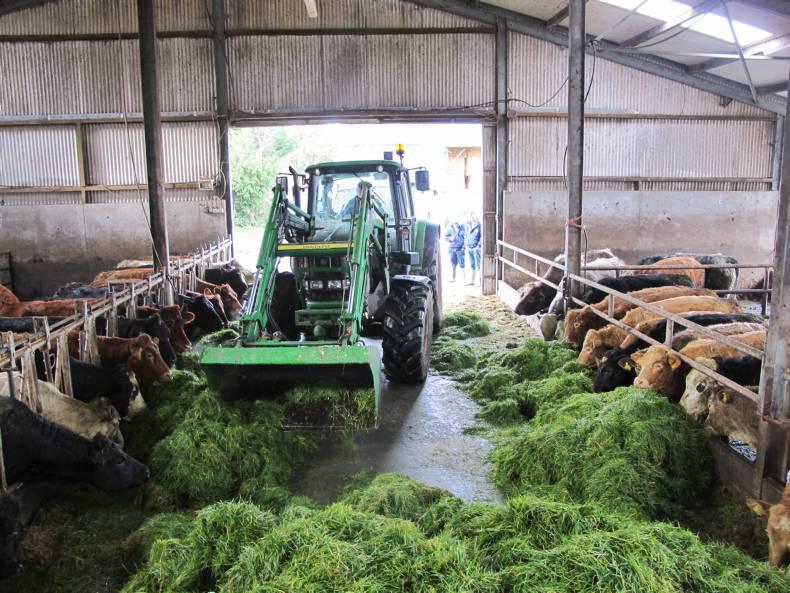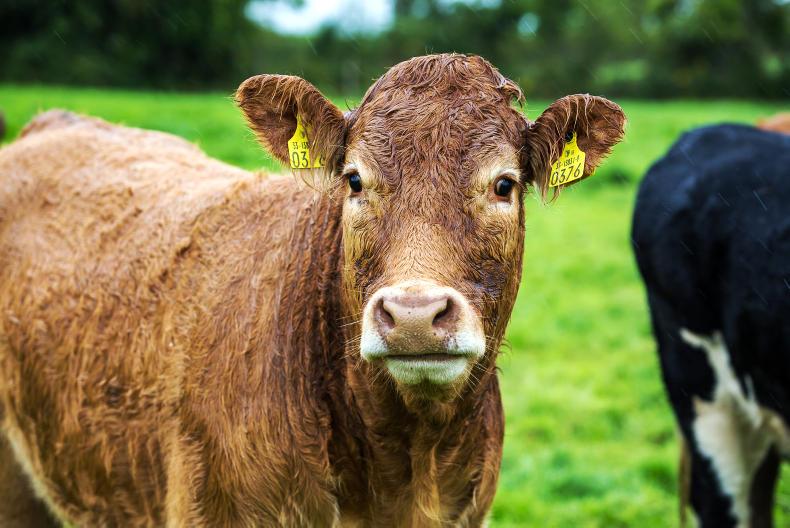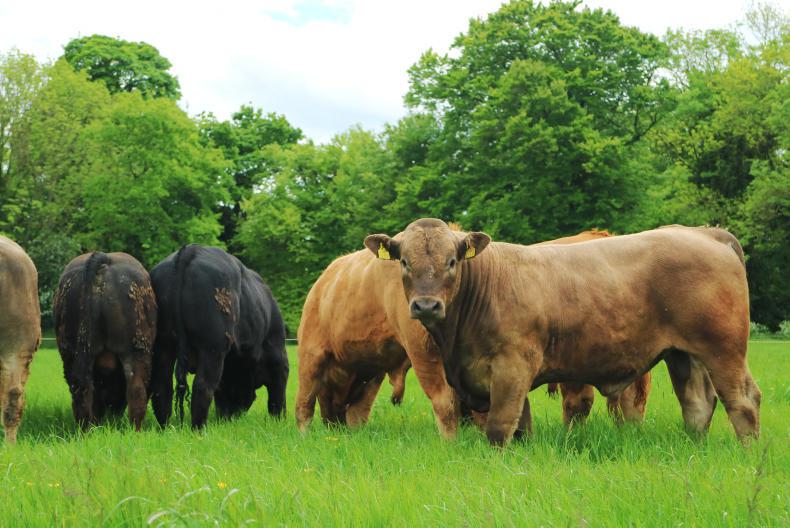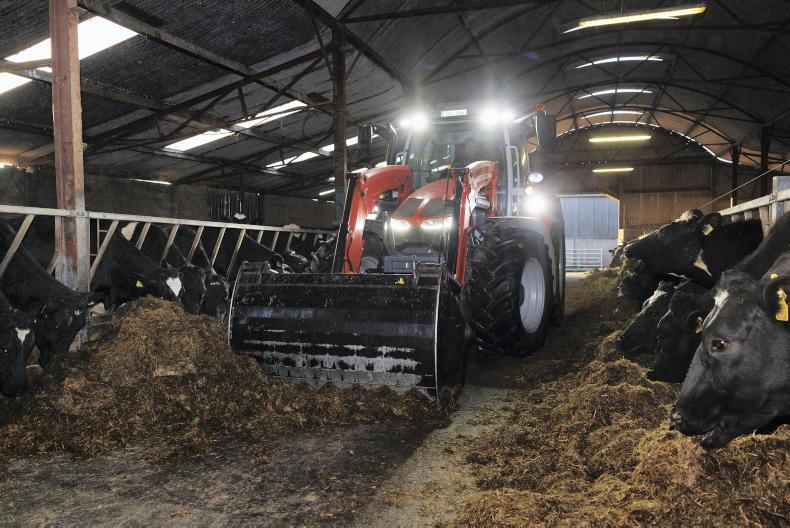For most farmers the thought of using a machine to cut grass and draw it to stock indoors is costly. Pat O’Reilly is a participant in the BETTER Farm programme that has gone down the route of buying a Belmac O-grazer for getting more grass into cattle, particularly bulls. The machine was purchased in March 2013 in the depths of the fodder crisis. In 2013 alone Pat Feels that the machine was a vital in reducing bought in feed and maintaining animal performance. Pat’s farm is in three sections. He runs a herd of 45 autumn calving suckler cows and 75 spring calving cows. His system see’s the top/export quality bulls sold live on the land. Heifers are sold as forward stores, with some killed off grass. Store cattle are bought in and 120 are killed each year between bulls, steers and heifers.
Zero grazing is carried out mainly on the home block of land as a means to get grass into stock in the early spring and autumn. The zero grazing process started at the end of January. In total 130 head of cows and calves are currently being fed on zero grazed grass alone. For the coming weeks Pat is focused on supplying 2/3 of the cattle’s daily intake from zero-grazed grass with during the day, and 1/3 through silage at night. The plan will be to let approximately 80 weanlings out to grass in the coming weeks if ground conditions remain favourable. The cows will remain indoors on grass and grass silage until turned out in mid-March.
Finishing cattle
One of the other main uses for the O-Grazer is feeding grass to bulls and autumn born yearling bulls later in the grazing season. It is not just an additional cost on the farm, but a management tool. The out-farm is dry in nature and frequently burns up in summer months. During this time grass is carted in using the O-Grazer.
Previously Pat had issues around grazing strong bulls, they become restless, walk a lot and in some cases have broken to heifers and cows. Housing the bulls and zero grazing them has helped to keep them content and maintain high weight gains. In addition finishing steers and heifers can be fed grass using the machine.
One thing he finds is that for finishing bulls, grass is removed from the diet for the last four weeks as he finds the high protein content keeps the bulls growing at a time when he wants them to stop. For that reason during the final four weeks of feeding ad-lib meal and straw are fed only. The last batch of bulls were slaughtered at 20 months of age and weighed from 440 to 460kg carcase weight. A group of heifers were slaughtered three weeks ago, they had an average carcase weight of 300kg and were all bought in. They were fed 5-6kg concentrates per day and ad-lib 73DMD silage.
Cost savings
The O-grazer on Pat’s farm is the Belmac O-grazer 70, capable of carrying up to 4 tonnes of fresh grass. Once filled, with fresh grass at 15% DM, it is estimated that each load would contain approximately 600kg of grass DM, and up to now pat was cutting 1.5 loads per day to feed the 45 suckler cows and approximately 85 weanlings. This has added significant cost savings to his system. Although weanlings typically would have been out to grass from mid-late February depending on ground and weather conditions. Typically none of the suckler cows would have gotten out grazing before mid-March. The O-grazer is now used to get cows onto grass from the end of January, a saving of approximatel six weeks on silage in the spring and another four weeks in the autumn.
It is estimated that this spring alone approximately 154 tonnes of silage have been saved, while over the entire year the total saving is estimated to be around 260 tonnes. At a cost of €25/tonne, this equates to a saving of over €6000. However, this is not a total saving as the grass grown and zero grazed will too have a cost. Pat estimates that the cost of cutting each load of grass uses about €4.00 of diesel, or slightly less than 1c/kg DM. In addition, the grass grown in place of the silage would be approximately 65t of DM, at an average cost of 6c/kgDM; this grass will have cost €3900 on grass alone; or €4500 when diesel is included. This shows a potential saving of about €1,500 excluding the cost of the machine.
Costs
There is no doubt that the machine does bring significant costs to the system. The machine itself cost €25,000 including VAT, spreading the cost of the machine over 5 years at 7.9% interest would result in a yearly cost of €6,069 for the machine. This may seem large and is extremely hard to quantify as estimating the cost of o-grazed grass will fundamentally depend on how much the machine is used during the year. On Pats farm it is used every day for 6-8 weeks in the spring and autumn.
It is also used on a daily basis for bringing grass into the bulls. For argument sake, we will presume that for six months of the year the machine is used for 1 load of grass each day. In total we will presume that 110t DM is passing through the machine; this equates to a cost of approximately 6c/kgDm.
Grazed grass costs approximately 6-7c/kgDM factoring in fertilizer, land cost etc. Using a machine like the O-grazer has its place on some farms due to fragmentation, system etc but it will almost double the cost of grazing in the initial years. Manufacturers of machines like the Belmac claim a life span of 10-15 years is achievable, this would reduce the cost of using the machine considerably from year five onwards, however at this stage maintenance costs will start to increase slowly.
We can try and estimate direct costs of using the machine and the savings. However, there are a significant number of factors which are not easily measured.
Pat finds that using the O-grazer in the spring to cut heavy covers, followed by applying 1500gals of watery slurry per acre increases the speed of grass growth on these fields. He also says that grass utilisation, particularly in early spring and autumn is almost 100%. Having cattle out grazing in these periods would, undoubtedly lead to tramping of grass and reduced grass utilisation.
Pat feels that this improved grassland utilisation, particularly in the spring helps him get early weight gain on weanlings at the same time as maximising utilisation and minimising grass losses. The other factor is that, as weanlings are on grass from late January, they are accustomed to a grass diet and no reduction in liveweight gain is experienced after turnout. In addition, because the cows are on a higher quality feed from January, no supplementation is required and a slightly tighter calving pattern in developing as a result.
Key points
· 45 autumn calving cows and 75 spring calvers.
· Top quality export type bulls sold off the land and heifers sold as stores.
· Bulls and stores bought in and 120 bulls, bullocks, heifers and cull cows slaughtered annually.
· O-grazer used from the end of January to Mid March and in the autumn to December.
· Fuel cost is estimated to be less than 1c/kgDm while the cost of the machine over 5 years is estimated to be near 6c/kgDM, but this will vary greatly depending on the amount of use.
· Bulls for finishing and strong autumn born bulls are O-grazed for management purposes.
· Bulls are taken off grass and moved to ad-lib meal for the final 4 weeks to get an adequate fat cover.












SHARING OPTIONS